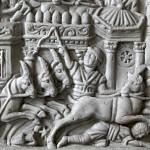
The Legend of the Great Horse trilogy takes place across many historical eras, from pre-history to modern times, and research was fundamental to telling the most accurate story I could. I followed a method I found enjoyable and fascinating, and it’s one I believe brought authenticity to the work.
Basically, I gathered writings from each era visited in the book, and spent significant time immersing myself in that culture. The thoughts and emotions of a literate society are reflected in its writing, and I found that by experiencing (reading) a variety of preserved texts a picture of the society could surface. I found a lot of surprises.
For example, one of the historical periods visited in Eclipsed by Shadow is ancient Rome. There’s no shortage of writing from our Roman ancestors, but there is a profusion of literary works of quality during the late Republic and early days of Empire. The first “novel,” Satyricon, was written then, and also the historical works of the great chronicler Tacitus. Reading facts about Rome along with works of Romans themselves reveals their world in a new and authentic way—through the eyes of our ancestors.
I learned how Rome grew as a new idea in the hearts of man: one of shared citizenship and the power of harmony. This early melting pot of foreign peoples was gradually corrupted by ongoing appeal to military virtues and primacy of commerce. Well, that’s a bit foreboding.
Tacitus was a former Consul who lived through nine emperors; he wrote bravely as his world was descending into debased madness that eventually ended in annihilation. Western civilization—the one I live in—literally died once before. If I’d been taught this history, I didn’t fully appreciate it in those terms.
I hope that my research provides the reader with something valuable and different in their knowledge of the world. The experience changed me. History is not always what it seems, and it is certainly not a closed book.